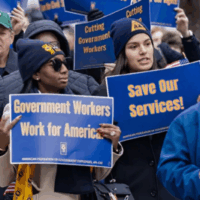Poll signals widespread business support for new proposal by Albany lawmakers to allow cities and counties to enact local minimum wages
New York, NY – Two out of three (66 percent) small business owners in New York think cities and counties should have the authority to set their own minimum wage rates above the state level, according to a new poll released by Small Business Majority. The poll signals broad levels of support among small businesses for legislation introduced this year (S. 6516/A. 9036) by State Senate Democratic Leader Andrea Stewart-Cousins and Assemblyman Karim Camara that would grant localities in New York the authority to set their own minimum wage rates.
The poll, conducted by Greenberg Quinlan Rosner Research, found that 77 percent of small business owners in New York support setting the minimum wage above the state’s current rate of $8 per hour, as well as indexing the minimum wage to rise each year with the cost of living. The respondents were predominately Republican–with 45 percent of small business owners identifying as Republican, 40 percent as Democrat and 15 percent as independent or other.
“Small businesses know that decent wages are a smart investment – and that poverty-level wages at major companies like Walmart and McDonald’s unfairly drain local communities and businesses of the spending power needed to sustain economic growth,” said Tsedeye Gebreselassie, staff attorney at the National Employment Law Project (NELP). “With wide variations in the cost of living throughout New York State, it only makes sense for Albany to empower cities and counties to set higher minimum wages that reflect local economic conditions.”
The poll released today found that 84 percent of small businesses in New York already pay all of their workers above the minimum wage, and that 74 percent agree that increasing the minimum wage would not only help the economy, but would make low-income consumers more likely to spend money, driving up demand for small businesses’ goods and services.
Over three million workers in New York–37 percent of the state’s labor force–work in low-wage jobs that pay less than $15 per hour, according to a 2014 report by the National Employment Law Project and the Fiscal Policy Institute. Census data show that workers of color in New York are disproportionately concentrated in low-wage jobs, with 49 percent of Hispanic workers and 48 percent of black workers throughout the state holding jobs that pay less than $15 per hour.
A growing number of localities across the country have already enacted minimum wages significantly above the federal and state level in an effort to address the impact of low-wage job growth and expanding inequality throughout the post-recession recovery. In March, the Richmond, CA City Council gave initial approval to a measure raising the city’s minimum wage to $12.30 per hour. This follows action in recent years by a number of localities that have established higher minimum wages, including San Francisco ($10.74 per hour), Santa Fe ($10.66 per hour), San Jose ($10.15 per hour), Washington, DC ($11.50 by 2016), Montgomery County, MD ($11.50 by 2017), Prince George’s County, MD ($11.50 by 2017), and SeaTac, WA ($15 for certain occupations).
Other cities currently considering higher minimum wages include Chicago ($15 per hour for large employers), Seattle ($15 per hour), San Francisco ($15 per hour), Oakland ($12.25 per hour), San Diego, Portland, ME, Davis, CA, and Las Cruces, NM, among others.
A 2011 study of citywide minimum wage increases by the Center for Economic and Policy Research examined minimum wage increases passed in Santa Fe, San Francisco, and Washington, D.C., and found that wages rose significantly for low-paid workers in fast-food, food services, retail, and other low-wage establishments in the years after each increase took effect, without causing any significant change in total employment levels.
A 2014 book-length study of San Francisco’s minimum wage, health care, and paid sick leave laws, which collectively raised the compensation of low-wage workers to 80 percent above the federal minimum wage, found that these laws raised pay without costing jobs. From 2004 to 2011, private sector employment grew by 5.6 percent in San Francisco, but fell by 4.4 percent in other Bay Area counties that did not have a higher local wage. Among food service workers, who are more likely to be affected by minimum wage laws, employment grew 17.7 percent in San Francisco, faster than in other Bay Area counties.
The most rigorous economic research over the past 20 years shows that raising the minimum wage boosts worker pay without causing job losses – even in regions where the economy is weak or unemployment is high. As summarized recently in a statement by 600 economists, including seven Nobel Laureates and eight past presidents of the American Economic Association, “In recent years there have been important developments in the academic literature on the effect of increases in the minimum wage on employment, with the weight of evidence now showing that increases in the minimum wage have had little or no negative effect on the employment of minimum-wage workers, even during times of weakness in the labor market.”
Emma Stieglitz
emmas@berlinrosen.com
(646) 200-5307



